
Classic Buses Profiles
Eastbourne Corporation half-cab double deckers (by Dick Gilbert)
Last updated 10 November 2022

SOME LINKS WITHIN THIS WEBSITE:
Home
Email
Links
THE COMPLETE WEBSITE MENU
Events Diary
Halfcab list
Small-Ads
Classic Irish Buses
Classic Manx Buses
Another look at some delightful vehicles from the past. This time we look at the varied fleet of
half cab double deckers that served Eastbourne, the famous and sunny holiday town in Sussex, on the south coast of England.
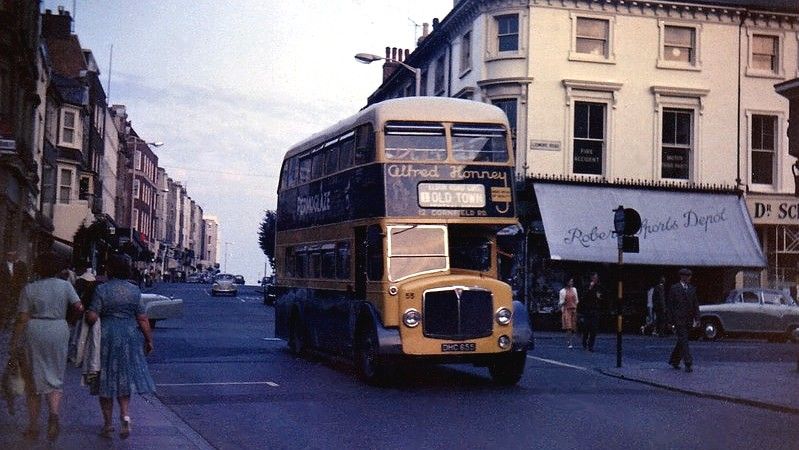
This fine picture of AEC Regent V no. 55 heading away from the sea down Terminus Road towards the
railway station and beyond, was taken by Bob Wilcox on 26 August 1964. Actually route 1 didn't run by the sea, but it did pass by
my old home in Old Town, so I used it a lot. That 6 in the registration number DHC 655 tells us that this batch (Eastbourne's
first Regent V buses) was delivered in 1956 - the first time that this numbering system was adopted. Sadly none of them survive
today. My thanks to Bob Wilcox for his kind permission to use this photo.
Eastbourne in Sussex holds a very special place in the history of bus transport, because its
Corporation was the first municipality in the world to receive consent for a motor bus service. Their first vehicle, a 14-seat
Milnes Daimler, commenced operations in April 1903, which was even before the days of registration number plates.
The town's bus service, later known as Eastbourne Buses, exceeded 100 years of continuous operation
before its takeover by Stagecoach in 2009, and certainly operated a wide variety of interesting vehicles around the delightful
and attractive resort, ranging from Clarkson steam buses and open-top De Dion Boutons to gearless Leyland Titans, but it is just
the halfcab double-deckers that are the subject of this page. The selection here is from 1930 to 1970 - which might be considered
the halfcab era. Accordingly, we start our overview from the arrival of the first stately Leyland Titan TD1s in 1930.
Then followed a steady stream of (mostly) Leyland products through the 1930s, building a fleet
which was sadly to suffer so heavily from the ravages of enemy action, as the town took a heavy toll in the hit and run raids
that the German air force inflicted on south coast towns during World War II. After a look at the surprising delivery of post-war
Crossleys, and the totally classic and perfectly-formed Bruce-bodied AEC Regents, our journey ends with the sadly far less
attractive fibreglass front PD2s of the late 1960s, and the strange story of the PD2 that was swapped for a PD3.
Eastbourne's connection with Bruce Coach Works, and their previous incarnation as Air Dispatch
(Coachbuilders) Ltd., was significant. Air Dispatch and Bruce mostly assembled products designed by East Lancs of Blackburn. The
Corporation bought the last four bodies to be built under the Air Dispatch name (nos. 25-27 and 40 in 1948), the first four
bodies to be produced under the Bruce name (nos. 28-31, also in 1948), and the very last, and finest, eight Bruce bodies to be
made (nos. 41-48 in 1951). When the Bruce factory closed in December 1951, Eastbourne stayed loyal to East Lancs designs and
continued to buy their products for many years.
I spent very frequent holidays with relatives in Eastbourne during the 1950s, and moved there in
1959 to spend my teenage years in the town, so I remember the fleet well during that period. My older brother (who spent a fair
bit of the wartime years in Eastbourne as a boy) remembers the sight and sounds of the gearless Leyland Titans, but my personal
memories really start with the TD4 and TD5 Titans that survived into the 1950s, and the fun of riding on the old open-toppers.
The conversion of many older buses to open-top configuration in the Corporation workshops during
the 1950s and 1960s gave them a new lease of life, and resulted in some quite ancient machines lasting well past their sell-by
date. This (and the sturdiness and popularity of the Regent Vs and PD2s) has led to a surprisingly high proportion of survivors
from the fleet, including some pre-war specimens. Details of all these are shown below.
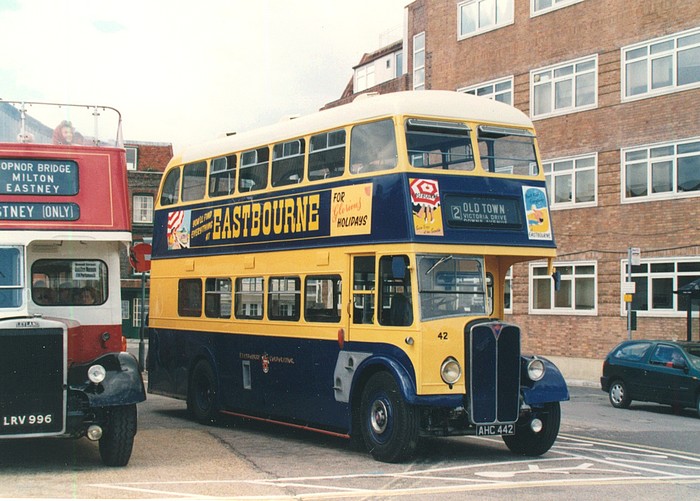
Taking my prize for the most elegant Eastbourne deckers were the 1951 batch of eight AEC Regent
IIIs with East Lancs bodywork sub-contracted to Bruce Coachworks in Wales. Happily one survives today, and here it is, no. 42
(AHC 442) seen at the Southdown Gathering, Portsmouth on 28 May 2000. Photo: Dick Gilbert.
A brief explanation of the Eastbourne Corporation numbering system would not go amiss. Basically,
they simply numbered vehicles from 1 upwards, but no numbers over 100 were permitted. Therefore, when the sequence looked like
approaching 100, they started again. The series therefore went round five times, but eventually continued beyond 100.
This means that a list in numerical order would be confusing, so it is instead arranged in date
order. Some numbers were changed occasionally to allow new batches to fit into the system, and very old vehicles that were still
in service when the sequence was going round again sometimes resulted in gaps or changes, but this will be explained as we go
along. HC and JK were the two vehicle registration identities for the town.
Various liveries were used throughout this period. The initial and most well-known was the blue/
primrose scheme, with open top seafront buses painted white. This was progressively replaced from around 1968 by cream with light
blue lining, but was again superceded by a deeper cream (known as vellum) and a darker blue from 1974 onwards, apparently due to
the difficulty in obtaining specific shades in relatively small quantities.
The Southdown enthusiasts club has kindly
given me permission to use some information from their publication Eastbourne Borough motor buses - the first 80 years, published
in 1983. My thanks to them for this, which has been of great assistance in preparing this page. I must also acknowledge the
invaluable help provided by various PSV Circle publications.
Inevitably mistakes are bound to creep in, and some relevant information may be missing so, in
order to make it as accurate a reference as possible, I would of course welcome any additions or corrections.
FLEET LIST
LEYLAND TITAN TD1 - 60-65 (2nd series) Total: 6
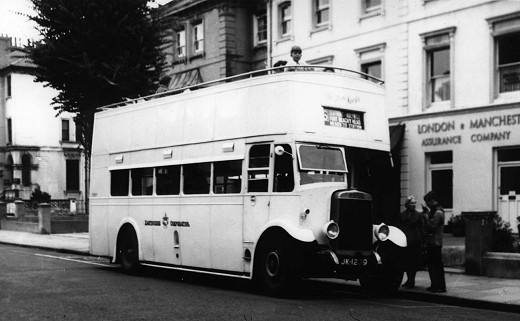
Leyland TD1 no. 64 (JK 1239) after conversion to open-top as the White Knight, waiting in
Gildredge Road to depart on seafront route no. 6 in the 1950s. Photo credit: not known, but kindly supplied by Dave Bran.
Delivered July 1930
Chassis: Leyland Titan TD1 petrol
Body: Leyland H24/24R piano front.
- 60 (JK 1235) - c/n 71451. Withdrawn Nov 1947, to Ace Lorry and Engineering Co. (dealer), Surbiton. In use as a store near Iwade 1953.
- 61 (JK 1236) - c/n 71452. Requisitioned by War Dept. Apr 1941
- 62 (JK 1237) - c/n 71453. Loaned to Southdown, Chichester Dec 1940 as no. 403, returned Feb 1941. Requisitioned by War Dept. Apr 1941
- 63 (JK 1238) - c/n 71454. Withdrawn July 1947, to Ace Lorry and Engineering Co. (dealer), Surbiton. To PMA Coaches (E.S.Smith), Purley 9/48 as C29F. Withdrawn 9/50 and became caravan, Romford by 1952.
- 64 (JK 1239) - c/n 71455. Rebodied in 1944 by East Lancs (2826) as H30/26R after severe damage by a German bomb in 1942 near the railway station. Reconfigured to H30/24R by 1947. Rebuilt 1950 as open top OT28/24R and named the White Knight. Withdrawn 1956. Later noted in a field near Horsham. Scrapped by 1/58.
- 65 (JK 1240) - c/n 71456. Withdrawn Nov 1947, to Ace Lorry and Engineering Co. (dealer), Surbiton.
LEYLAND TITAN TD1 - 66-75 (2nd series) Total: 11
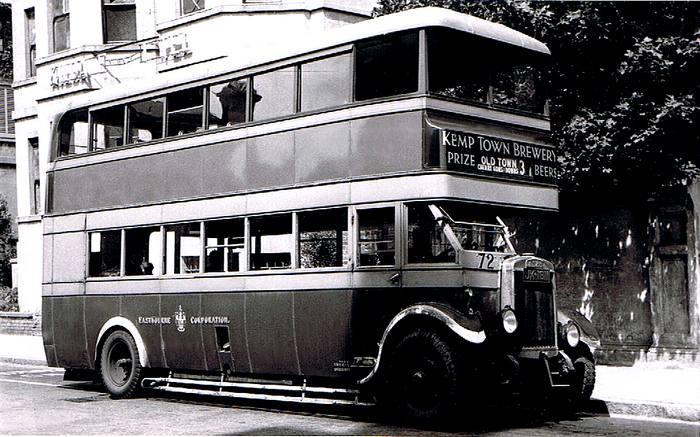
Leyland TD1 no. 72 (JK 1811) probably immediately post-war, on route 3 to Old Town. Pete Carter
helped me establish that the photo was taken outside the Kildare hotel (now demolished) in Trinity Place, just short of the
seafront. Photo W. J. Haynes by kind permission of the Southdown enthusiasts club.
Delivered August 1931
Chassis: Leyland Titan TD1 petrol
Body: Leyland H24/24R piano-front
- 66 (JK 1805) - c/n 72166. Withdrawn Sept 1948. To Blair (dealer), Manchester. Later became a caravan in Cardigan.
- 67 (JK 1806) - c/n 72167. Withdrawn Sept 1948
- 68 (JK 1807) - c/n 72168. Loaned to Lancashire United Transport as no. E68 1941-42. Withdrawn Sept 1948. To Blair (dealer), Manchester. With E. Holland (showman), Salford 1949.
- 69 (JK 1808) - c/n 72169. Loaned to Southdown, Chichester Dec 1940 as no. 402, returned Feb 1941. Withdrawn 1949, and later with Carricrop Trailers (dealer), London SW18, and later with H. H. Motors (dealer), Old Kent Road, London.
- 70 (JK 1809) - c/n 72170. Withdrawn Sept 1948. To Blair (dealer), Manchester.
- 71 (JK 1810) - c/n 72171. Withdrawn 1949, and later with Carricrop Trailers (dealer), London SW18, and later with H. H. Motors (dealer), Old Kent Road, London.
- 72 (JK 1811) - c/n 72172. Withdrawn Jan 1948, to Ace Lorry and Engineering Co. (dealer), Surbiton. Later noted in a yard in Chessington.
- 73 (JK 1812) - c/n 72173. Loaned to Lancashire United Transport as no. E73 1941-42. Withdrawn Jan 1948, to Ace Lorry and Engineering Co. (dealer), Surbiton. Noted in a field near Birmingham 8/49, reportedly with an STL-type body.
- 74 (JK 1813) - c/n 72174. Loaned to Lancashire United Transport as no. E74 1941-42. Withdrawn Oct 1948. With Escort Coaches (J. and B. Downey), London E6 1/49. Withdrawn 11/50 and became a caravan.
- 75 (JK 1814) - c/n 72175. Rebodied 1947 East Lancs H30/26R as a result of war damage. Reconfigured to H50R 1947. Rebuilt 1950 as open top O28/24R and named the White King. Withdrawn 1956.
LEYLAND TITAN TD2 - 76-80 (2nd series) Total: 5
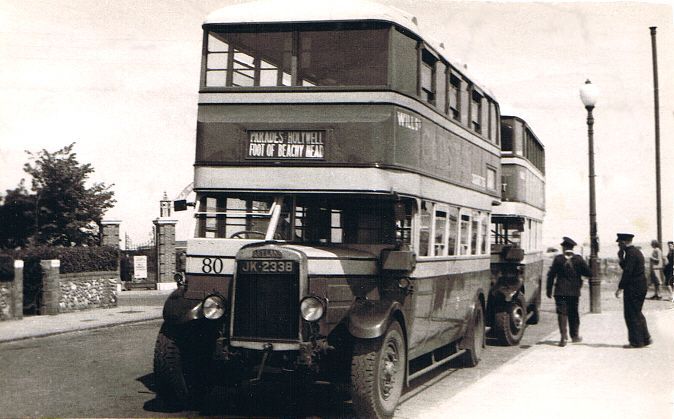
No. 80 (JK 2338) on seafront duties in original condition at Princes Park Gates, probably in the
late 1940s. (Photo unknown).
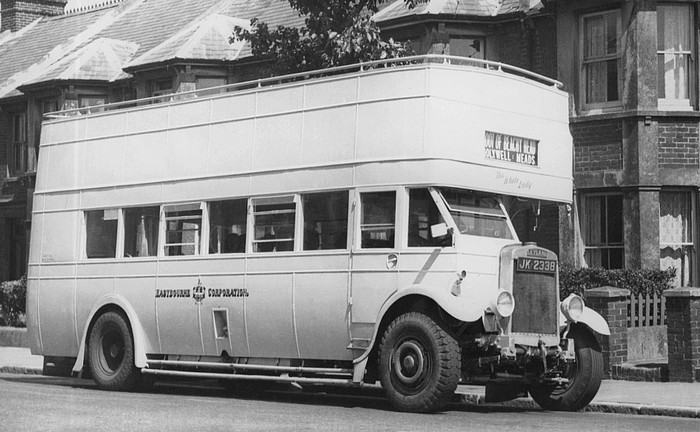
No. 80 as rebuilt to open-top around 1950, possibly in Channel View Road. (Photo: Roy Marshall
collection, via East Pennine transport group, Huddersfield)
Delivered June 1932
Chassis: Leyland Titan TD2 petrol
Body: Leyland H24/24R piano front.
- 76 (JK 2334) - c/n 1215. Loaned to Southdown, Chichester Dec 1940 as no. 401, returned Feb 1941. Loaned to Lancashire United Transport as no. E76 from 1942 to 1944. Withdrawn Oct 1949 and broken up for spares.
- 77 (JK 2335) - c/n 1216. Loaned to Lancashire United Transport as no. E77 from 1942 to 1944. Rebuilt Oct 1949 to open top O28/24R and named the White Princess. Withdrawn Oct 1954 and scrapped.
- 78 (JK 2336) - c/n 1217. Loaned to Lancashire United Transport as no. E78 from 1942 to 1944. Rebuilt Oct 1949 to open top O28/24R and named the White Queen. Withdrawn Oct 1954. Seen at Rye 9/56. Behind Rye East Kent depot 12/59. To Brown, Pevensey 4/60 as a shed.
- 79 (JK 2337) - c/n 1218. Loaned to Southdown, Chichester Dec 1940 as no. 400, returned Feb 1941. Loaned to Lancashire United Transport as no. E79 from 1942 to 1944. Rebuilt June 1950 to open top O28/24R and named the White Rabbit. Withdrawn Nov 1953 and scrapped 1954.
- 80 (JK 2338) - c/n 1219. Loaned to Lancashire United Transport as no. E80 from 1942 to 1944. Rebuilt July 1949 to open top O28/24R and later named the White Lady. Withdrawn Dec 1953.
LEYLAND TITAN TD3c - 81-86 (2nd series) Total: 6
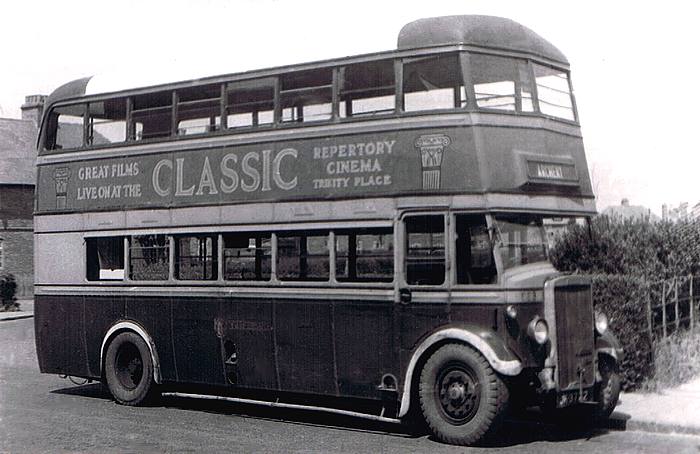
Leyland TD3 no. 83 (JK 3722) wearing a wartime subdued grey/blue livery (although curiously with
a white roof), probably in Churchdale Road. Photo W. J. Haynes by kind permission of the Southdown enthusiasts club.
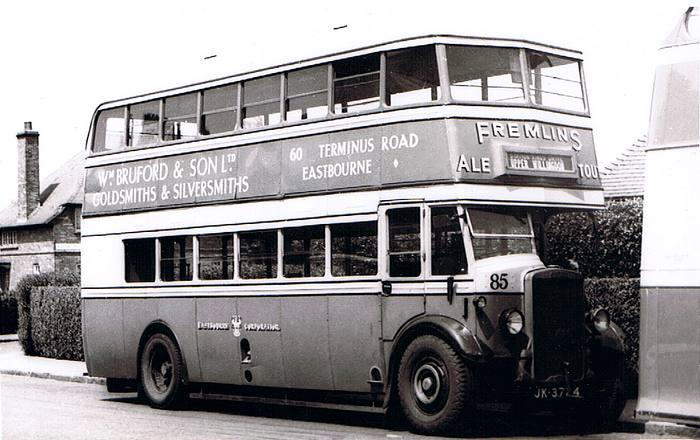
Leyland TD3 no. 85 (JK 3724) probably in the late 1940s and probably at the bottom of Churchdale
Road. Photo W. J. Haynes by kind permission of the Southdown enthusiasts club.
Delivered August 1934
Chassis: Leyland Titan TD3c gearless buses with torque converters (which were later removed) and
petrol engines.
Body: Leyland H24/24R
Notes: Some loaned to Southdown and Lancashire United during World War II, certainly including no.
83 which went to LUT as their no. E83, but not no. 86 which remained in Eastbourne throughout the hostilities.
- 81 (JK 3720) - c/n 4769. Loaned to Southdown, Worthing Jan 1941 as no. 400, returned 1943. Withdrawn July 1949 and broken up for spares at Churchdale Road. Top deck still in use as a bike shed at Corporation bus depot, Churchdale Road, 1961.
- 82 (JK 3721) - c/n 4770. Loaned to Lancashire United Transport as no. E82 from 1942 to 1944. Withdrawn Apr 1950 and broken up for spares at Churchdale Road depot.
- 83 (JK 3722) - c/n 4771. Loaned to Lancashire United Transport as no. E83 from 1942 to 1944. Withdrawn Apr 1951 and broken up for spares at Churchdale Road depot.
- 84 (JK 3723) - c/n 4772. Withdrawn Sept 1950 and sold to Escort Coaches (J. and B. Downey), London E6. To C. W. Banfield, London SE17 6/52, withdrawn 12/54.
- 85 (JK 3724) - c/n 4773. Loaned to Southdown , Worthing Jan 1941 as no. 403, returned 1943. Withdrawn Sept 1950 and sold to Lammas Motors (dealer), London SW9.
- 86 (JK 3725) - c/n 4774. Withdrawn Apr 1950 and broken up for spares at Churchdale Road depot.
LEYLAND TITAN TD4c - 87-90 (2nd series) Total: 4
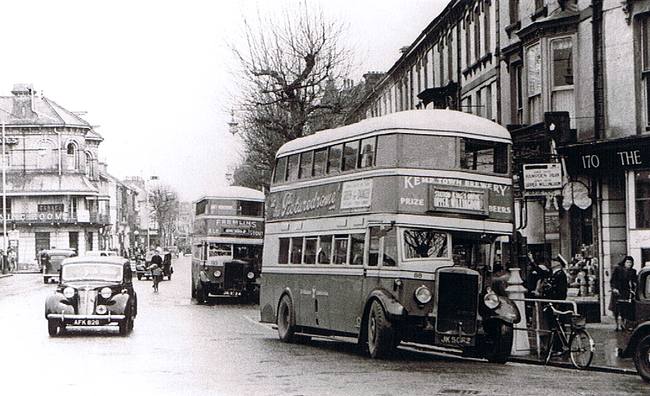
No. 88 opposite Eastbourne railway station, probably in the late 1940s, about to depart for Kings
Drive and Upper Willingdon. Behind it is no. 85, one of the gearless TD3s, coming to the end of its life. It wears a strange
fleet number on the front which looks like 165. (Photo: possibly Roy Marshall Collection, or maybe Dave Spencer collection).
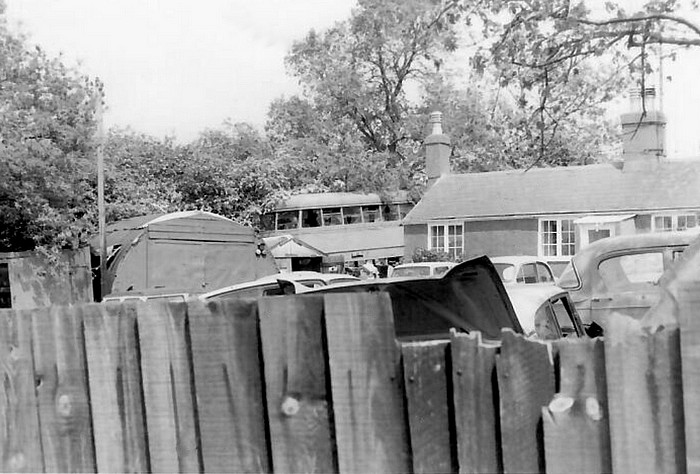
Peter Burton wrote in May 2013: "I remember seeing a Leyland TD4 with the Leyland metal-framed
body in a builder's yard in Hastings when seeking out old buses. I lived in Bexhill on Sea from 1971 to 1974 so can state that
Eastbourne 90 (JK 5064) was still in existence in the early 1970s, and even had Eastbourne transfers just showing. It was a long
time ago now and memory has faded, other than it was on high ground in East Hastings."
Leon Coast kindly sent me this picture in February 2022. It came from the Roy Simmons collection
(although not taken by him) and is reproduced with his permission. It shows no. 90 (JK 5064) in its final resting place in a
scrap yard in Old Top Road, Ore. Leon said "no doubt the obligatory alsations prevented the photographer from getting any closer!
We are fairly sure this is Winchester's scrap yard."
Delivered October 1935
Chassis: Leyland Titan TD4c with petrol engines and torque converters.
Body: Leyland H24/24R
- 87 (JK 5061) - c/n 7905. Withdrawn Oct 1950 and sold to Lammas Motors (dealer), London SW9.
- 88 (JK 5062) - c/n 7906. Loaned to Southdown, Worthing Dec 1940 as no. 404, returned 1943. Withdrawn July 1951. Sold to S. Beeney (dealer) 1952 and scrapped.
- 89 (JK 5063) - c/n 7907. Loaned to Southdown, Worthing Jan 1941 as no. 402, returned 1943. Withdrawn July 1951 and sold to J. J. and B. R. Downey (Escort Coaches), London E6. Chassis lengthened 5/52 (becoming c/n 7907/21520), received Plaxton FC38F body {1826} and re-registered FHV 1. To Everyman's Coaches (L. and R. Brockhurst), Maudlin, Chichester 9/54. To Horlock and Sons, Northfleet 9/60 as no. 44. To Wheatley (dealer), Bean, Kent 1/65. Registration re-used on SYX 573F in 1983.
- 90 (JK 5064) - c/n 7908. Requisitioned by Royal Navy 1940, returned by 4/52 and withdrawn. In use as a shed (engineless) at Hastings by 12/52 and still there 6/58. See also "Notes" above.
AEC REGENT - 91-93 (2nd series) Total: 3
Delivered June 1936
Chassis: AEC Regent 661
Body: Strachans H24/24R
Notes: Eastbourne's first AEC purchases.
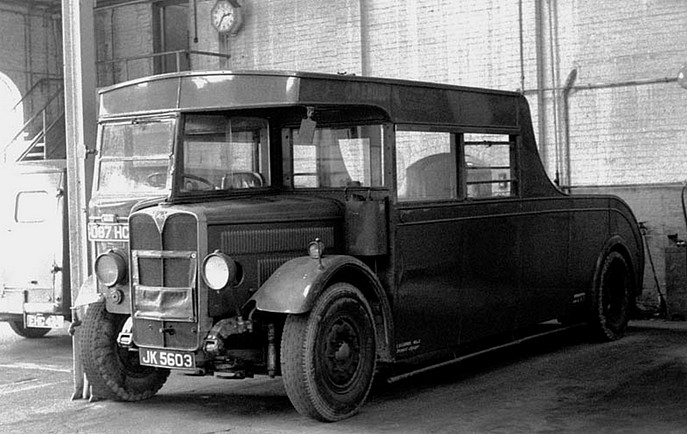
Here is no. 93 (JK 5603) in the Churchdale Road depot after conversion to breakdown truck Monty
in 1948. The picture was taken by Paul Redmond and comes from his
fabulous collection of bus, coach, truck and railway photos. Many thanks to Paul.
- 91 (JK 5601) - c/n 6614381. Requisitioned by Royal Navy in March 1941, and severely damaged by enemy action while on active service.
- 92 (JK 5602) - c/n 6614382. Requisitioned by Royal Navy in March 1941. To Oakwell Motors (H. and L. Wharam), Barnsley 9/49, fitted with Barnsley Co-op C33F body and reregistered CHE 131. Barnsley British Co-op Society (Unity) 6/54. To R.H.Williams, Pontefract 3/56. To C. Saxton, Heanor from 4/57 to 8/58. To Kirkby (dealer), South Anston, and then to Percy Bilton (contractor), London W5. Last licenced 7/60.
- 93 (JK 5603) - c/n 6614383. Body destroyed by enemy action in 1940. Converted to breakdown vehicle Monty Aug 1948. Withdrawn Nov 1965 and apparently passed to F. A. Green, Gravesend, for use in moving preserved vehicles. At Stafford Transport Training Board, Llanelli by 8/83 for preservation. David Hoare, c/o West of England Transport Collection, Winkleigh 1984. South Eastern Bus Collection by 4/85 for preservation.
(Jim Crichton kindly provided more details about this. It seems that (possibly) F. A. Green of
Gravesend was also the owner of another tow wagon, ex Western SMT 1943 AEC Matador no. 0853. The Regent was reportedly later
scrapped, and its registration number transferred to the Matador, which had carried a Q prefix plate. Matador JK 5603 is now at
the Scottish Vintage Bus Museum.)
LEYLAND TITAN TD4c - 94-96 (2nd series) Total: 3
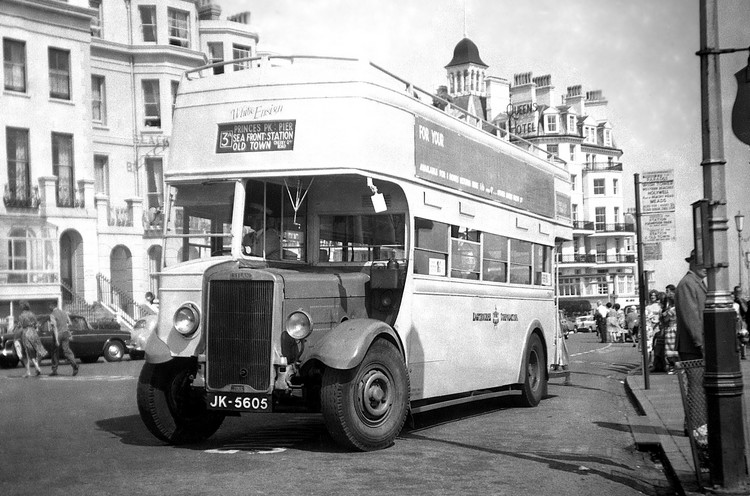
Leyland Titan no. 95 (JK 5605) was already 25 years old when photographed at the Pier in 1961. It
had been converted to open-top and named White Ensign nine years earlier and was coming to the end of its considerable service
life. Photo: Dick Gilbert.
Delivered July 1936
Chassis: Leyland Titan TD4c with petrol engines and torque converters (which were removed in 1954);
fitted with 8.6 litre oil engines in 1953. Eastbourne Corporation bought 12 vehicles from Southdown in the early 1950s (including
Leyland TS7 Tigers, numbers 1407, 1408, 1419 and 1115 from 1935, Leyland TD4 Titans, numbers 100, 101, 107 and 150 from 1935-36,
Leyland TS8 Tigers, numbers 1432 and 1469 from 1938-39) in order to use their Leyland 8.6 litre diesel engines.
Body: Leyland H24/24R
- 94 (JK 5604) - c/n 11078. Loaned to Southdown, Worthing Dec 1940 as no. 405, returned c. April 1943. Rebuilt 1952 to open top O28/24R and named White Heather. Received oil engine from unknown Southdown Leyland, 1953. Withdrawn July 1961 and sold to Alexander and Walker (dealer), Bretforton, Worcs.
- 95 (JK 5605) - c/n 11079. Loaned to Southdown, Worthing June 1942 as no. 400, returned 1944. Rebuilt 1952 to open top O28/24R and named White Ensign. Received 8.6 litre oil engine 4/53 from Southdown TD4 no. 107 (BUF 207). Withdrawn Aug 1963, sold to Eastbourne Civil Defence and painted dark green. To WETC for preservation, 1967. **SURVIVOR** David Hoare, Chepstow. See photo here.
- 96 (JK 5606) - c/n 11080. Loaned to Southdown, Worthing Jan 1941 as no. 403, returned 1943. Received 8.6 litre oil engine from unknown Southdown Leyland in 1953. Rebuilt 1956 to open top O30/26R and named the White King. Withdrawn May 1963, and sold to Creamline, Bordon as a tree-lopper. Derelict by 9/63.
LEYLAND TITAN TD5c - 1-5 (3rd series) Total: 5
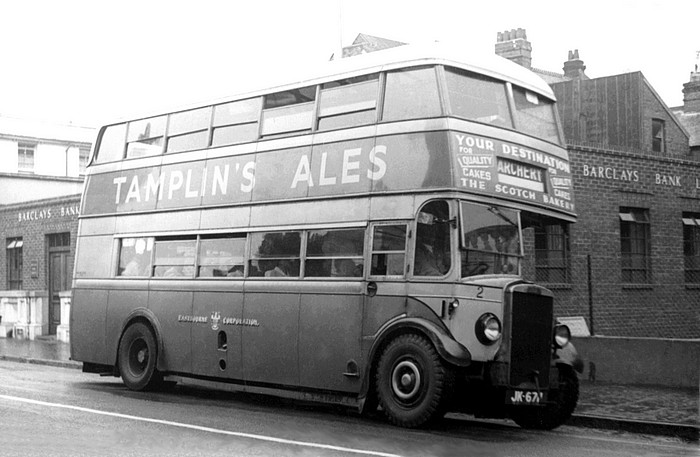
All-Leyland Titan TD5 no. 2, probably in Seaside in the early 1950s. Photo: Roy Marshall
collection, by permission of the East Pennine transport group, Huddersfield.
To see a picture of this bus after conversion to open-top, click here.
Delivered July 1937
Chassis: Leyland Titan TD5c with torque converters (removed in 1954); engines later replaced (see
notes below).
Body: Leyland H24/24R (c. 1951 reconfigured to H26/24R or H30/26R).
Notes: Eastbourne Corporation bought 12 vehicles from Southdown in the early 1950s (including
Leyland TS7 Tigers, numbers 1407, 1408, 1419 and 1115 from 1935, Leyland TD4 Titans, numbers 100, 101, 107 and 150 from 1935-36,
Leyland TS8 Tigers, numbers 1432 and 1469 from 1938-39), in order to use their Leyland 8.6 litre diesel engines. These were then
fitted to numbers 1, 2 and 3, but no. 4 was given an AEC 9.6 litre engine, and no. 5 received a 7.4 litre engine as fitted to the
Titan PD1.
- 1 (JK 6710) - c/n 15305. Received 8.6 litre oil engine 6/52 from Southdown TD4 no. 101 (BUF 201). Withdrawn 1956 and scrapped at Churchdale Road depot 1/57.
- 2 (JK 6711) - c/n 15306. Loaned to Lancashire United Transport as no. E2 from 1942 to 1944. Received 8.6 litre oil engine 7/52 from Southdown TD4 no. 100 (BUF 200). Rebuilt 1956 to open top O30/26R and named the White Rose. Withdrawn May 1963, sold to Creamline, Bordon as a tree-lopper, summer 1963.
- 3 (JK 6712) - c/n 15307. Loaned to Lancashire United Transport as no. E3 from 1942 to 1944. Received 8.6 litre oil engine 8/54 from Southdown TS7 no. 1408 (BUF 988). Withdrawn Aug 1957 and sold to C. W. Banfield, London SE15. Still with them 10/60.
- 4 (JK 6713) - c/n 15308. Loaned to Lancashire United Transport as no. E4 from 1942 to 1944. Received 9.6 litre AEC engine 1952. Withdrawn 1957. Shed at St.Leonards by 6/58.
- 5 (JK 6714) - c/n 15309. Loaned to Lancashire United Transport as no. E5 from 1942 to 1944. Received 7.4 litre Leyland engine 9/51. Withdrawn August 1957 and scrapped at Churchdale Road depot.
AEC REGENT II - 6-10 (3rd series) Total: 5
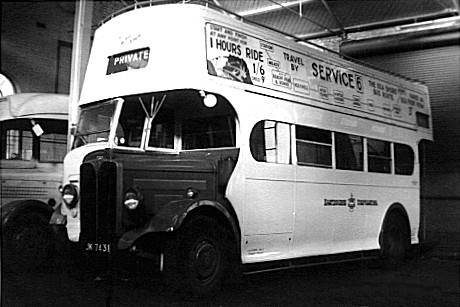
No. 10 (JK 7431) in its open-top guise as the White Knight at Churchdale Road garage in 1960,
shortly before its withdrawal and sale. It had only been converted from petrol to diesel four years previously. It was to survive
for at least another 27 years, but seems to have been finally defeated by the great storm of October 1987. Photo: Dick Gilbert.
Delivered August 1938
Chassis: AEC Regent II 661. Nos. 7 to 10 had 8.6 litre oil engines fitted in 1954 (see notes below).
Body: Northern Counties H24/24R
Notes: These are believed to be the last AEC Regent buses delivered with petrol engines.
Eastbourne Corporation bought 12 vehicles from Southdown in the early 1950s (probably TS7 Tigers),
in order to use their Leyland 8.6 litre diesel engines, nos. 7 to 10 received these engines in 1954, while no. 6 was given a 9.6
litre AEC engine.
- 6 (JK 7427) - c/n 6616128. Loaned to Lancashire United Transport as no. E6 from 1942 to 1944. Fitted with 7.7 litre AEC oil engine in 1951. Re-engined and rebuilt 1954 to open top O28/24R and named the White Princess. Withdrawn July 1961, to Eastbourne Civil Defence Division as a practice vehicle.
- 7 (JK 7428) - c/n 6616129. Loaned to Lancashire United Transport as no. E7 from 1942 to 1944. Re-engined and rebuilt 1954 to open top O28/24R and named the White Rabbit. Withdrawn Feb 1962, sold to Light (breaker), Lewes for scrap.
- 8 (JK 7429) - c/n 6616130. Re-engined and rebuilt 1954 to open top O28/24R and named the White Lady. Withdrawn Feb 1962, sold to Light (breaker), Lewes for scrap.
- 9 (JK 7430) - c/n 6616131. Loaned to Lancashire United Transport as no. E9 from 1942 to 1944. Re-engined and rebuilt 1954 to open top O28/24R and named the White Queen. Withdrawn July 1961, sold to Alexander and Walker (dealer), Wotton-under-Edge. Loaned to Alexander (Greyhound), Sheffield, but not used, and returned. Became a fairground vehicle, seen at Wansted 4/61, Hertford 6/65 and in a yard at Writtle 7/65.
- 10 (JK 7431) - c/n 6616132. Re-engined and rebuilt 1956 to open top O28/24R and named the White Knight. Sold in 1960 (or 1962?) to Thomas Bros. (Port Talbot) Ltd. for seafront services in South Wales - renamed Sandfields Belle. To Way (dealer), Cardiff 5/65, and still there 3/75. West of England Transport Museum, Winkleigh 1978. At Chalk Pits Museum, Amberley, Sussex in 1985. Moved to Eastbourne and stored in a shed at Wenhams, which was destroyed by the hurricane of 1987. Probably scrapped after that.
LEYLAND TITAN PD1 - 13-18 (3rd series) Total: 6
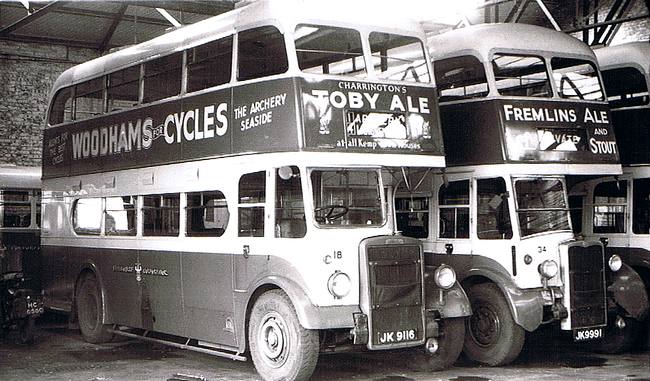
Titan PD1 no. 18 sits in the Churchdale Road garage alongside Crossley no. 34, probably around
1960. The two styles of East Lancs bodies can be compared, with the Crossley being two years newer. The Leyland was to be
converted to open-top during the winter of 1962-63 for seafront services, lasting in this form until 1968. Photo: unknown.
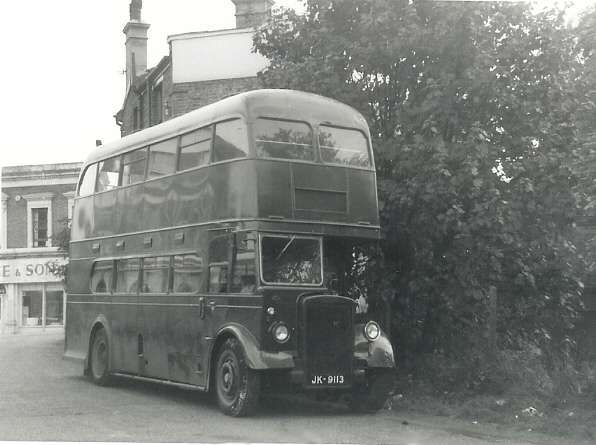
This unusual photo taken by Peter Esposito and kindly supplied by Chris Stanley, showing no. 15
(JK 9113) in Penge on 13 October 1968, a few months after its retirement from Eastbourne service and sale to Margo's Coaches.
This was the only one of the batch not to be converted to open-top.
Delivered October 1946 (except no. 17 delivered in May 1947)
Chassis: Leyland Titan PD1
Body: East Lancs H28/24R. Five later converted to open-top, with upper deck front windscreens.
Notes: Eastbourne's first diesel buses.
- 13 (JK 9111) - c/n 460580, b/n 4083. Reseated to H26/24R by 1/51. Rebuilt late 1961 to open top O30/26R, in service 1962. Reseated to H31/26R in 1962. Reseated to H30/26R c.1964. Withdrawn Feb 1968, sold to the Royal Coach Inn, Houston, Texas, painted red and cream in 1969.
- 14 (JK 9112) - c/n 460584, b/n 4081. Reseated to H26/24R by 1/51. Rebuilt late 1961 to open top O30/26R, in service 1962. Reseated to H30/26R c.1964. Withdrawn Feb 1968.
- 15 (JK 9113) - c/n 460588, b/n 4082. Reseated to H26/24R by 1/51. Apparently in process of rebuild to open-top, Aug 1963, but reverted to a normal-roofed double decker in 1964. Reseated to H30/26R in 1964. Later became a driver trainer. Withdrawn Feb 1968, sold to Margo (Europa Coaches), Penge, London SE20, used as a service van. To Saunders (dealer), London SE8 4/69 for scrap.
- 16 (JK 9114) - c/n 460589, b/n 4084. Reseated to H26/24R by 1/51. Rebuilt late 1961 to open top O30/26R, in service 1962. Reseated to H30/26R c.1964. Withdrawn Feb 1968.- sold to Royal Coach Inn, Atlanta, Georgia, May 1968 Michael Overcash, t/a Green Knight Tours and Atlantic Double Deckers, Georgia USA 2000 (semi-derelict).**SURVIVOR**
- 17 (JK 9115) - c/n 461661, b/n 4090, deliv.5/47. Reseated to H26/26R by 1/51. Taken out of service 1962, then rebuilt Nov 1962 - Feb 1963 to open top O30/26R with front passenger windscreen. Withdrawn Feb 1968, to C. Durham, Meopham by 6/69 for preservation. **SURVIVOR** Bole, Dover, Kent - For sale for £1000 February 1999. At West of England Transport Collection, Winkleigh 2007, with David Hoare, Chepstow 2008.
- 18 (JK 9116) - c/n 460590, b/n 4085. Reseated to H26/26R 1951. In use as training bus early 1962, but back in service again by Sept 1962. Rebuilt Oct 1962 - July 1963 to open top O30/26R. Withdrawn Jan 1968 and sold to C. Tennant, Stockton on Tees for publicity purposes. Round Britain Cycle Race support vehicle c.1970. The Samaritan (Samaritans?), Eaglescliffe 5/71. To Barraclough (dealer), Carlton 6/76, sold for scrap 10/76.
AEC REGENT II - 19 (3rd series) Total: 1
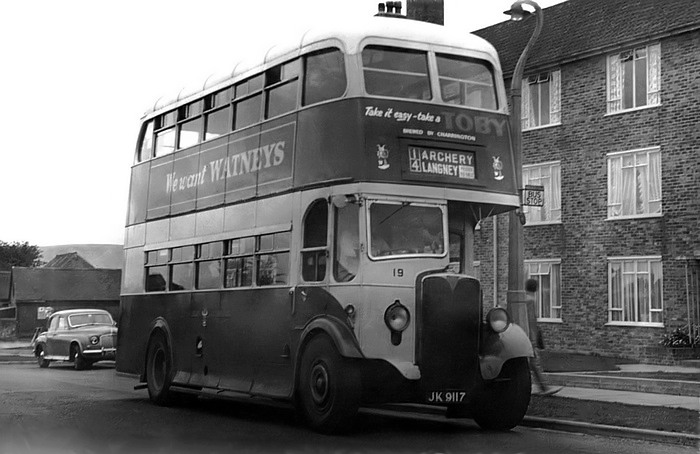
Immediately post-war, Eastbourne Corporation would gratefully accept whatever new buses were
available from manufacturers, which accounts for the arrival of this one-off diesel-engined AEC Regent in 1946, although other
similar buses were to follow later. This is probably taken somewhere in the Central Avenue area. Photographer unknown, but taken
on 3 August 1962.
Delivered October 1946
Chassis: AEC Regent II O661, number O6617645, with 7.7 litre diesel engine.
Body: Weymann H30/26R, no. M2884.
Notes: Eastbourne's first diesel-engined AEC, and its first Weymann body.
- 19 (JK 9117) - c/n O6617645, b/n M2884. Reseated to H26/24R by 1/51. Reseated to H30/28R in 1960. Later used as driver trainer. Withdrawn June 1967, sold to Wombwell Diesels (dealer), Wombwell.
AEC REGENT III - 20-24 (3rd series) Total: 5
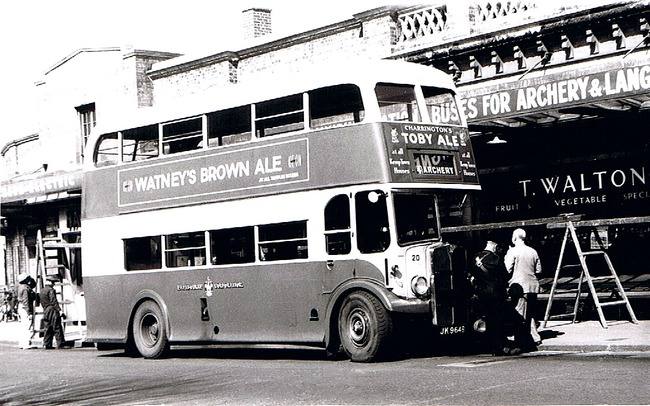
Stopping at the railway station and bound for the Archery terminus of Route 4 around 1960 is
Regent III no. 20 with a four-bay Weymann body very similar to the East Lancs products that Eastbourne was also buying during the
immediate post-war period. Clearly the station frontage is having a repaint, while the conductor takes a break, leaning against
the front mudguard in the traditional Eastbourne sunshine. Photo: unknown.
Delivered May 1947
Chassis: AEC Regent III O961
Body: Weymann H28/22R
Notes: Had their lower deck seats replaced by ex London Transport trolleybus seats in 1960, and
became H30/26R at that time.
- 20 (JK 9648) c/n O961894, b/n M3220 - Reseated to H26/24R by 1/51. Withdrawn Apr 1966 when the 1966 Titan PD2s (71-80) were delivered. To Wombwell Diesels (dealer) for scrap.
- 21 (JK 9649) c/n O961895, b/n M3224 - Reseated to H26/24R by 1/51. Withdrawn Apr 1966 when the 1966 Titan PD2s (71-80) were delivered. To Wombwell Diesels (dealer) for scrap.
- 22 (JK 9650) c/n O961896, b/n M3221 - Reseated to H26/24R by 1/51. Withdrawn May 1967. To Wombwell Diesels (dealer) for scrap.
- 23 (JK 9651) c/n O961897, b/n M3222 - Reseated to H26/24R by 1/51. Withdrawn Apr 1966 when the 1966 Titan PD2s (71-80) were delivered. To Wombwell Diesels (dealer) for scrap.
- 24 (JK 9652) c/n O961898, b/n M3223 - Reseated to H26/24R by 1/51. Withdrawn May 1967. To Wombwell Diesels (dealer) for scrap.
LEYLAND TITAN PD2/1 - 25-27 (3rd series) Total: 3
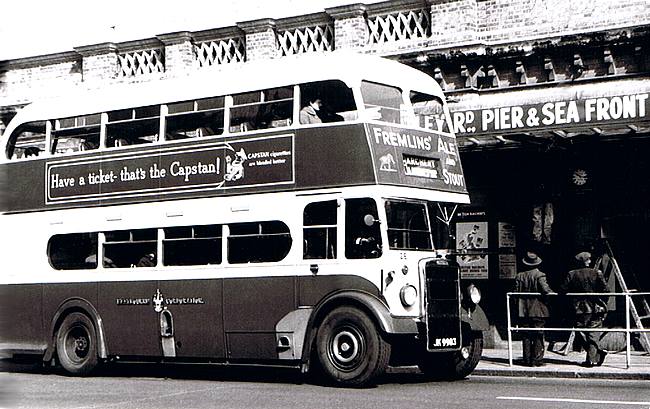
No. 26 (JK 9983) outside Eastbourne railway station. Photo: Unknown.
Delivered February 1948
Chassis: Leyland Titan PD2/1
Body: East Lancs H28/24R, assembled by Air Dispatch (Coachbuilders) Ltd. at Cardiff, which were to
be renamed Bruce Coach Works in September 1948.
- 25 (JK 9982) c/n 471808, b/n 4317 - Reseated H26/24R by 1/51 and to H28/26R in 1960. Withdrawn June 1967. To Wombwell Diesels (dealer). In use as a tow wagon by 1968.
- 26 (JK 9983) c/n 471828, b/n 4315 - Reseated H26/24R by 1/51 and to H30/26R in 1960. Withdrawn Feb 1968. To a Bexhill dealer. Top deck used as chicken house, Cowbeech by 1970.
- 27 (JK 9984) c/n 471829, b/n 4316 - Reseated H26/24R by 1/51 and to H28/26R in 1960. Withdrawn Feb 1968. To a Bexhill dealer. To Walter Llewellyn (contractor), Eastbourne by 5/68. Gone by 9/68.
AEC REGENT III - 28-31 (3rd series) Total: 4

Bruce-bodied AEC Regent no. 28 at Eastbourne Railway Station in 1961. This was the first bus to
be delivered from the Cardiff factory of Bruce Coach Works, as they had previously been known as Air Dispatch (Coachbuilders) Ltd.
prior to Sept 1948. Photo: Dick Gilbert.
Delivered April 1948
Chassis: AEC Regent III O961
Body: East Lancs / Bruce H28/24R (the first buses to be delivered with bodies made by Bruce Coach
Works, Cardiff, and the first built to a four-bay design).
- 28 (JK 9985) c/n O9612637, b/n 4386 - Reseated H26/24R by 1/51, and to H30/26R in 1960. Withdrawn Apr 1966 when the 1966 Titan PD2s (71-80) were delivered. To Wombwell Diesels (dealer).
- 29 (JK 9986) c/n O9612638, b/n 4387 - Reseated H26/24R by 1/51, and to H30/26R in 1960. Withdrawn Apr 1966 when the 1966 Titan PD2s (71-80) were delivered. To Southdown Gliding Club, Firle 6/66, engine used as glider towing winch, seats used in clubhouse. Still owned 8/75.
- 30 (JK 9987) c/n O9612639, b/n 4384 - Reseated H26/24R by 1/51, and to H30/26R in 1960. Withdrawn Apr 1966 when the 1966 Titan PD2s (71-80) were delivered. To Wombwell Diesels (dealer).
- 31 (JK 9988) c/n O9612640, b/n 4385 - Reseated H26/24R by 1/51, and to H30/26R in 1960. Withdrawn Apr 1966 when the 1966 Titan PD2s (71-80) were delivered. To Wombwell Diesels (dealer). To C.Bartle (Transport), Dewsbury 8/66, withdrawn 11/68 and scrapped.
CROSSLEY DD42/5 - 32-39 (3rd series) Total: 8
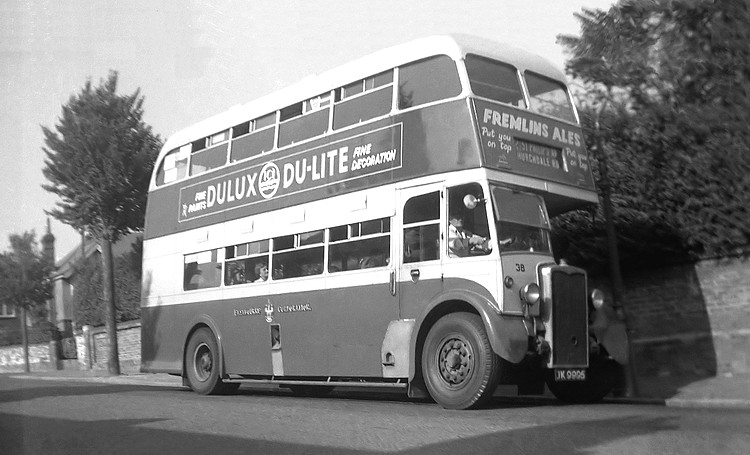
Crossley no. 38 nearing the end of its life, on Route 2 in Green Street, Old Town in 1961. Photo:
Dick Gilbert.
Delivered May-June 1948
Chassis: Crossley DD42/5
Body: East Lancs H28/22R
- 32 (JK 9989) - c/n 94083, b/n 4468, deliv.6/49. Reseated H26/24R by 1/51, and to H30/26R in 1960. Withdrawn Sept 1963. Stored outside, then sold to Marchant's Coaches, Cheltenham. Withdrawn 7/67.
- 33 (JK 9990) - c/n 94084, b/n 4470, deliv.6/49. Reseated H26/24R by 1/51, and to H30/26R in 1960. Withdrawn Sept 1963. Stored outside, then sold to Marchant's Coaches, Cheltenham. Overturned 4/64 and sold for scrap 5/64.
- 34 (JK 9991) - c/n 94085, b/n 4466, deliv.5/49. Reseated H26/24R by 1/51, and to H28/26R in 1960. Withdrawn Sept 1963. Stored outside, then sold to Marchant's Coaches, Cheltenham. Used as H26/26R with platform doors. Withdrawn 1/68 and sold to a Gloucester dealer.
- 35 (JK 9992) - c/n 94086, b/n 4469, deliv.6/49. Reseated H26/24R by 1/51, and to H30/26R in 1960. Withdrawn Sept 1963. Stored outside, then sold to Marchant's Coaches, Cheltenham. Withdrawn 10/68 and to Gloucester dealer for scrap.
- 36 (JK 9993) - c/n 94087, b/n 4464, deliv.5/49. Reseated H26/24R by 1/51, and to H28/26R in 1960. Withdrawn Oct 1962, sold to Marchant's Coaches, Cheltenham. Used as H26/26R. Withdrawn 2/67 and sold to a Gloucester dealer 1/69 for scrap.
- 37 (JK 9994) - c/n 94088, b/n 4467, deliv.5/49. Reseated H26/24R by 1/51, and to H30/26R in 1960. Withdrawn Sept 1963. Stored outside, then sold to Marchant's Coaches, Cheltenham. Withdrawn 9/68 and to Gloucester dealer for scrap.
- 38 (JK 9995) - c/n 94089, b/n 4465, deliv.5/49. Reseated H26/24R by 1/51, and to H30/26R in 1960. Withdrawn Sept 1962, sold to Marchant's Coaches, Cheltenham. Withdrawn 10/68 and to Gloucester dealer for scrap.
- 39 (JK 9996) - c/n 94091, b/n 4463, deliv.5/49. Reseated H26/24R by 1/51, and to H30/26R in 1960. Withdrawn Sept 1962, sold to Marchant's Coaches, Cheltenham.Withdrawn 7/64 and to Gloucester dealer for scrap.
LEYLAND TITAN PD2/1 - 40 (3rd series) Total: 1
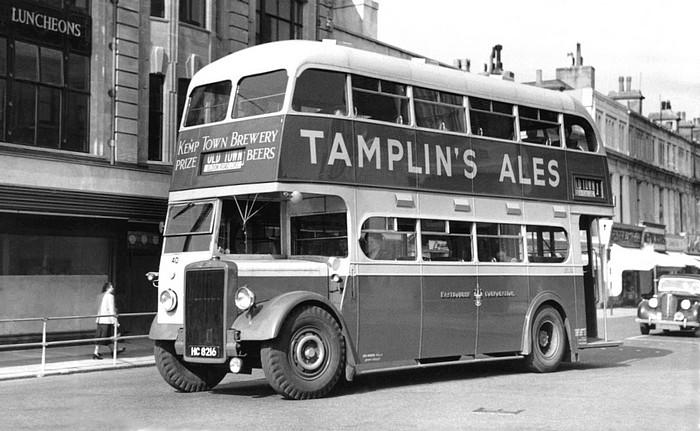
On a typical Eastbourne sunny day in the 1950s, no. 40 turns out of Seaside Road into Terminus
Road heading for the railway station and Old Town on route 1. Hand-painted beer adverts commonly adorned Eastbourne buses, yet
curiously never for the town's own Star Brewery. Photo: Roy Marshall collection, by permission of the East Pennine transport
group
Delivered March 1948
Chassis: Leyland Titan PD2/1
Body: East Lancs H28/24R, assembled by Air Dispatch (Coachbuilders) Ltd. at Cardiff, which were to
be renamed Bruce Coach Works in September 1948.
Notes: All body beading and mudguards at one time painted dark blue, but the picture above shows it
in more conventional livery (although the radiator surround may be light blue). Which came first?
The story of its out-of-sequence registration is interesting. Buses Illustrated for November 1967
records it thus:
This bus formed part of a programme of sixteen new double deckers (four AEC, eight Crossley and
four Leyland) which were allocated registrations JK 9982-9997. A well-known local lady owned a large Humber car registered HC
9997 in pre 1939-45 war days and, when buying a new car in 1948 asked to have JK 9997, which had been earmarked for no. 40. It
was arranged for the lady to have JK 9997, and HC 8216 was allocated to the bus. Why this number? Well, HC was started in 1910
from 1 for cars and lorries etc., and 2 for motorcycles, and this odd/even split was maintained until HC 9999 was reached for
cars (about 1929). Even numbered HC marks lagged behind and eventually reached 80xx range. JK was finished in 1948 and it was
then decided to complete the issue of the even numbers of HC. Hence no. 40 became HC 8216.
- 40 (HC 8216) c/n 480861, b/n 4318 - Reseated H26/24R by 1/51 and to H30/26R in 1960. Withdrawn July 1967, and sold to Wombwell Diesels (dealer).
AEC REGENT III - 41-48 (3rd series) Total: 8
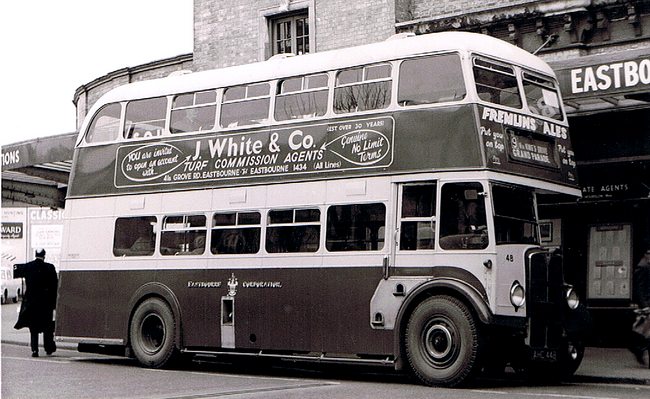
Another picture at Eastbourne railway station on 18 March 1961 shows no. 48 (AHC 448) one of the
beautiful 1951 AEC Regent IIIs with Bruce bodies. Personally I see these buses as the pinnacle of post-war provincial double-
decker bus design. Bruce Coach Works of Cardiff built only 142 bodies, all between 1948 and 1952, and assembled under licence
from East Lancs Coachbuilders of Blackburn. This batch of Eastbourne Regents were the last bodies to be built by Bruce, and this
one (no. 48) was the last but one. no. 47 was the very final bus to leave the factory, in December 1951.
My thanks to Peter J. Relf who took and supplied the photo (no. 01879).
Delivered Oct-Nov 1950
Chassis: AEC Regent III, 9613A, crash gearboxes.
Body: East Lancs / Bruce Coachworks five-bay H30/26R.
Notes: no. 42 was fitted with an illuminated advertisement panel on the lower deck front bulkhead
in 1965.
- 41 (AHC 441) c/n 9613A5635, b/n 4721 - Delivered Sept 1951. Withdrawn Apr 1971, sold to Sidebottom (dealer), Swinton.
- 42 (AHC 442) c/n 9613A5636, b/n 4719 - Delivered June 1951. Withdrawn Jan 1971 and sold for preservation. **SURVIVOR** with Eastbourne Regent Preservation Group, kept at Portsmouth Bus Museum 2002.
- 43 (AHC 443) c/n 9613A5637, b/n 4716 - Delivered May 1951. Withdrawn Nov 1970, sold to Sidebottom (dealer), Swinton.
- 44 (AHC 444) c/n 9613A5638, b/n 4720 - Delivered Aug 1951. Withdrawn Apr 1971. Sold to I.and B.Margo (Europa Coaches), London SE19. Roof badly damaged. To Lister (dealer), Bolton 5/71 and to Barraclough (dealer), Carlton 2/72.
- 45 (AHC 445) c/n 9613A5639, b/n 4718 - Delivered June 1951. Withdrawn Nov 1970, sold to Sidebottom (dealer), Swinton. In 1971 it was rumoured to have been sold for preservation, but this was apparently not correct.
- 46 (AHC 446) c/n 9613A5640, b/n 4717 - Delivered June 1951. Withdrawn Feb 1971, sold to Sidebottom (dealer), Swinton.
- 47 (AHC 447) c/n 9613A5641, b/n 4723 (the very last Bruce-built body) - Delivered Dec 1951. Withdrawn Apr 1971, sold to Sidebottom (dealer), Swinton.
- 48 (AHC 448) c/n 9613A5642, b/n 4722 - Delivered Oct 1951. Withdrawn July 1970 after accident damage, sold to Sidebottom (dealer), Swinton.
AEC REGENT V - 49-55 (3rd series) Total: 7
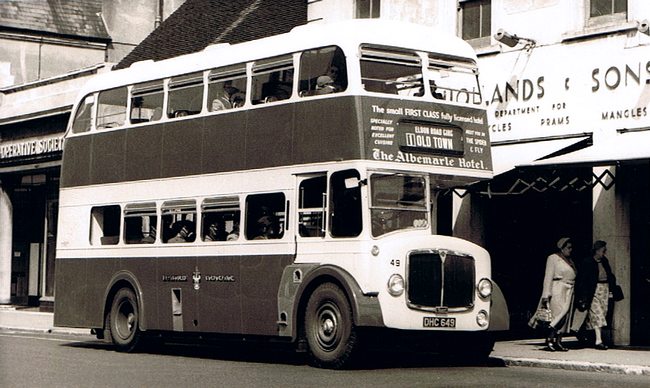
Eastbourne's first AEC Regent V, no. 49 (DHC 649) when new in May 1956. The shop D. Hollands and Sons
(selling bicycles, prams and mangles!), dated back to the 1930s but did not last another five years after this picture was taken.
The demand for mangles had obviously declined. Photo: G.Mead.
Delivered Mar-May 1956. Nos. 49-51 entered service on Good Friday 1956.
Chassis: AEC Regent V, D3RV
Body: East Lancs H30/26R, 8 foot wide.
Notes: Eastbourne's first 8 foot wide buses.
- 49 (DHC 649) - c/n D3RV144, b/n 5221. Repainted in new livery 1971, and to second new livery in 1975. Loaned to London Country, Reigate from 1/76 to 6/76. Withdrawn Aug 1980, to Rollinson (dealer), Carlton, and to J.Sykes (dealer), Carlton by 9/80.
- 50 (DHC 650) - c/n D3RV145, b/n 5220. Remained in the old livery until withdrawn. Stored winter 1972/73 and withdrawn Jan 1973. Bought by Hayward and de Courcey (George's Coaches), Coventry 11/73. Operating school services for George's Coaches 1974, painted red and cream. Withdrawn 12/75.
- 51 (DHC 651) - c/n D3RV146, b/n 5222. Remained in the old livery until withdrawn Jan 1973. Bought by Hayward and De Courcey (George's Coaches), Coventry 11/73. Operating school services for George's Coaches 1974, painted red and cream. Withdrawn 12/75, scrapped at Walsall Wood by 4/76.
- 52 (DHC 652) - c/n D3RV147, b/n 5223. Withdrawn Nov 1970 (the first Regent V to go). To Brunt and Aylett (dealer), Sittingbourne 5/71. With Eastons (Eastonways), Ramsgate in 1973. Also reported with Sevenscore Estates (farmers), Ramsgate in 1972.
- 53 (DHC 653) - c/n D3RV148, b/n 5226. Repainted in new livery 1969. Withdrawn Sept 1975. With Lister (dealer), Bolton 6/77.
- 54 (DHC 654) - c/n D3RV149, b/n 5225. Withdrawn Dec 1970. To Brunt and Aylett (dealer), Sittingbourne 5/71. With Scott and Knowles, Chartham 9/71, and to a dealer, Stanwell, 1978 for scrap.
- 55 (DHC 655) - c/n D3RV150, b/n 5224. Repainted cream with blue trim in 1969. Withdrawn Nov 1975 and to Castle (dealer), Northampton for resale to Northern Ireland (to take Belfast children on holidays). To Pace, Belfast 1978.
AEC REGENT V - 56-60 (3rd series) Total: 5
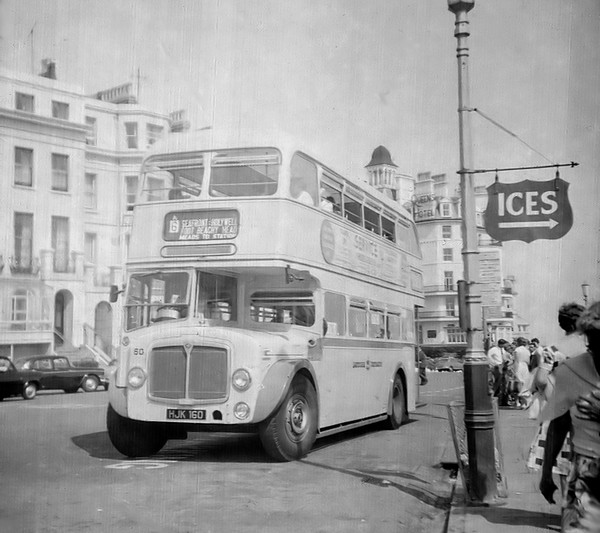
No. 60 at the Pier in 1962. The translucent roof can be seen. (Photo: Dick Gilbert)
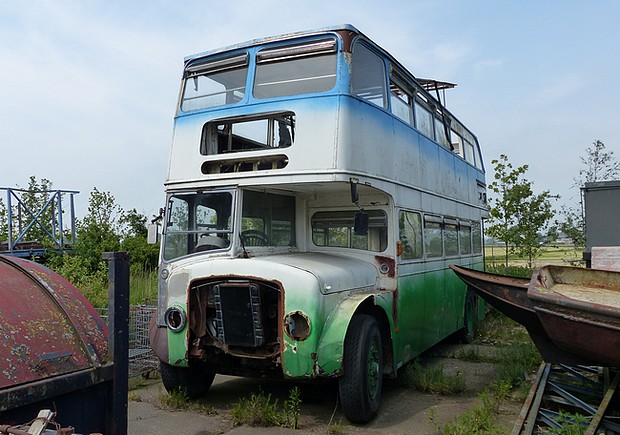
No. 57 at Mart Leek's premises in Holland, 2019. (Photo by Peter Skerry)
Delivered May-June 1961
Chassis: AEC Regent V, 2D3RV, 27 foot long, 8 foot wide, 9.6 litre engines.
Body: East Lancs H32/28R. The upper deck had translucent roof panels and full-drop opening windows.
Platform doors were fitted to three of this batch in 1968 for use on town tours.
Notes: Delivered in cream/light blue livery. Each chassis cost £2,768.
- 56 (HJK 156) - c/n 2D3RV959, b/n 5769. Delivered end May 1961. Platform doors fitted Feb 1968. Withdrawn Aug 1981, to P. G. Bird (Ongar Coaches), High Laver 10/81. To Busby Coaches, Harlow 9/82. Withdrawn by 7/85.
- 57 (HJK 157) - c/n 2D3RV960, b/n 5771. Delivered June 1961 (but had previously been entered into the Blackburn Carnival by East Lancs and won 1st prize in its group). Withdrawn Aug 1981. To B. Birks, Eastbourne 10/81 for preservation. At South Coast Driving School, Sidley 1986. With Mart Leek, Monnikendam, Holland c.2005 re-registered as XWV 612A. With Mart Leek at De Rijp, Holland 2019 with lifting roof and re-registered as BE-32-97. See photo above. **SURVIVOR**
- 58 (HJK 158) - c/n 2D3RV961, b/n 5770. Delivered June 1961. Withdrawn Jan 1980, to Rollinson (dealer), Carlton 5/80.
- 59 (HJK 159) - c/n 2D3RV962, b/n 5773. Delivered June 1961. Platform doors fitted Mar 1968. Withdrawn July 1978. To Booth (dealer), Rotherham 12/78, cut down for use as yard truck.
- 60 (HJK 160) - c/n 2D3RV963, b/n 5772. Delivered June 1961. Platform doors fitted Sept 1968. Loaned to London Country, Reigate in 5/76. Withdrawn Sept 1978. To Booth (dealer), Rotherham 12/78 and scrapped.
AEC REGENT V - 61-65 (3rd series) Total: 5
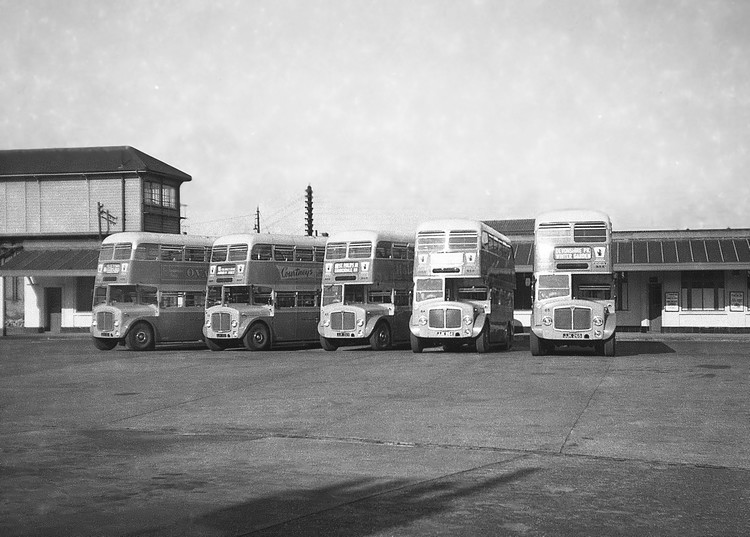
When the 1962 (third) batch of Regent Vs (nos. 61-65) were delivered new in July, they were
immediately driven round to the Central Coach Station by the railway in Ashford Road, to be lined up for a photocall for the
local press. This was quite unusual, as Corporation buses were seldom seen in the coach station. Your intrepid reporter was, of
course, there to record the event! Photo: Dick Gilbert.
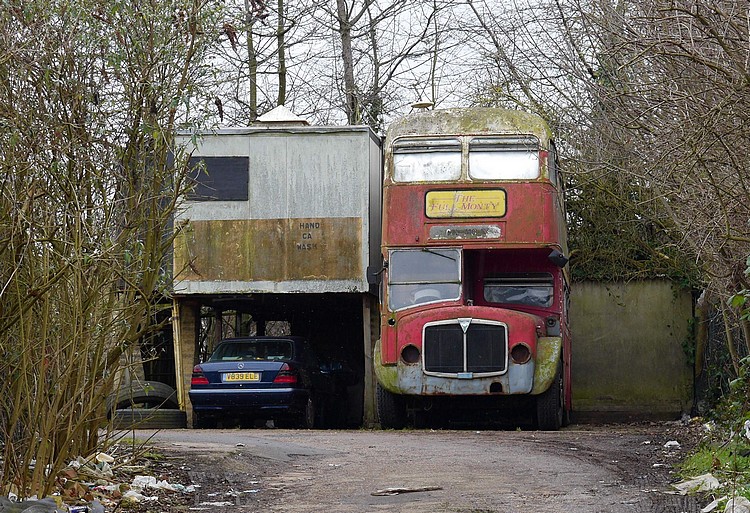
The only known survivor of this batch is no. 65 (JJK 265) is seen here in February 2015 at
Wycombe Road, Wembley, where it has stood since at least 2003. Photo by kind permission of John Rogers, via Ian Pleace.
Delivered July 1962
Chassis: AEC Regent V, 2D3RV
Body: East Lancs H32/28R
Notes: Delivered in blue/primrose livery, but with paler blue than used previously. However they
were repainted in the normal blue during 1965-66. They were then repainted into the new livery of cream with light blue lining
during 1968-69.
- 61 (JJK 261) - c/n 2D3RV1098, b/n 5865. Loaned to London Country in 1/76. Withdrawn Sept 1979. With Girl Guides 2/80. Later in Crawley area as the Bewbush Playbus.
- 62 (JJK 262) - c/n 2D3RV1099, b/n 5863. Withdrawn Nov 1973. Sold to Campden Coaches, Sevenoaks. To Ensign (dealer), Hornchurch 10/76. Converted to open-top by Southend Corporation, painted in London Transport livery and exported to Holland for Van Dam Tours. J. Quiltin, Roubaix, France 8/79, re-registered 9625.JQ.59 9/82, used for mobile puppet theatre.
- 63 (JJK 263) - c/n 2D3RV1100, b/n 5866. Withdrawn June 1979. To Rollinson (dealer), Carlton 11/79.
- 64 (JJK 264) - c/n 2D3RV1101, b/n 5864. Withdrawn Jan 1973. To George's Coaches (Hayward and de Courcey), Coventry 11/73 for school services, painted red and cream. Withdrawn 12/75.
- 65 (JJK 265) - c/n 2D3RV1102, b/n 5867. The first to be repainted in new cream livery, Dec 1968. Loaned to London Country from 1/76 to 6/76. Withdrawn Feb 1979. Sussex Community Bus Association, Falmer 3/79 as a childrens' adventure bus. Later became a playbus in Wokingham. To a new owner in Woodley, Berks 1998, possibly as a mobile caravan. Seen laid up in poor condition at Lee's Garage Abbey Works, Wycombe Rd., Wembley (but not owned by them) in June 2003. Still there, and still basically complete in early 2015.**SURVIVOR**
AEC REGENT V - 66-70 (3rd series) Total: 5
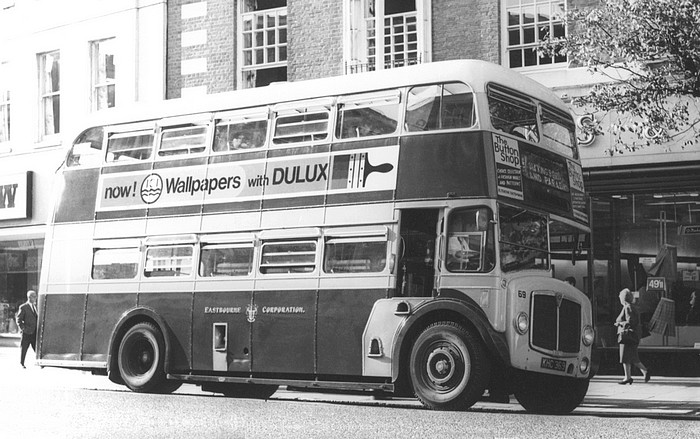
No. 69 in Terminus Road, wearing the original livery. Photo: unknown.
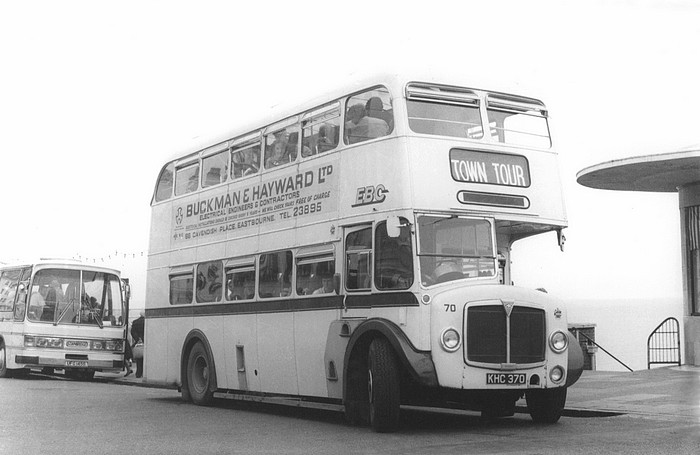
No. 70 at the Pier, in the later revised livery. Photo: unknown.
Delivered May 1963
Chassis: AEC Regent V, 2D3RV
Body: East Lancs H32/28R
- 66 (KHC 366) c/n 2D3RV1261, b/n 5695 - Crashed into corner of Lamb Inn, Old Town on 22 June 1965 after collision with Southdown Commer TS3 coach no. 20. Rebuilt by East Lancs (Neepsend) and returned 12/65. Repainted cream in 1970. Withdrawn May 1975, and converted to breakdown vehicle no. 98. Picture here. Re-registered as VSV 990 in Jan 1988, but regained KHC 366 number in 2007. **SURVIVOR** Ian Grindrod, Cornwall 2010, under long-term restoration.
- 67 (KHC 367) c/n 2D3RV1262, b/n 5966 - The last in the fleet to wear the old blue / primrose livery (finally repainted in 1975). Loaned to London Country, Reigate, from 2/76 to 6/76. Withdrawn Aug 1980. To P. Scott, Nottingham. Used as psv 9/81 to 8/83 then retained for preservation. **SURVIVOR** Glenn Turner, Southampton (acquired 1996).
- 68 (KHC 368) c/n 2D3RV1263, b/n 5962 - Repainted cream with blue trim in 1969. Loaned to London Country, Reigate, from 12/75 to 6/76. Withdrawn June 1980. To C. Parmenter, Hove 12/80 for preservation. Re-registered as XWV 416A around 1989. **SURVIVOR** Dave Connell, Eastbourne. To Chris Pearce, Worthing 2007. To Neil Morgan, Brighton 2010, re-registered as KHC 345.
- 69 (KHC 369) c/n 2D3RV1264, b/n 5964 - Platform doors fitted Feb 1971 and repainted in new livery. Withdrawn May 1980. Acquired by R. Mower and others 12/80 for preservation. **SURVIVOR** 69 Group, Doncaster 2002. Passed from Ken Hulks to Steven Wood, Hertford in November 2003. Restoration complete by 2006. Picture here.
- 70 (KHC 370) c/n 2D3RV1265, b/n 5963 - Platform doors fitted Oct 1970 and repainted in new livery. Withdrawn Aug 1981, to P. Bird (Ongar Coaches), High Laver. Withdrawn by 7/85.
LEYLAND TITAN PD2A - 71-80 (3rd series) Total: 10
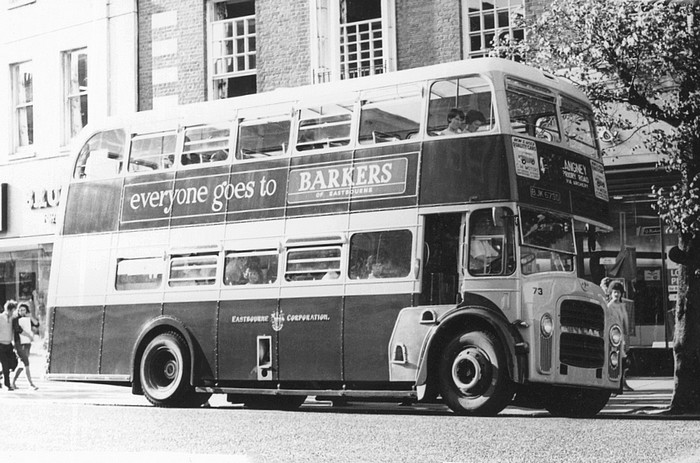
No. 73 in Terminus Road. Photo: Unknown.
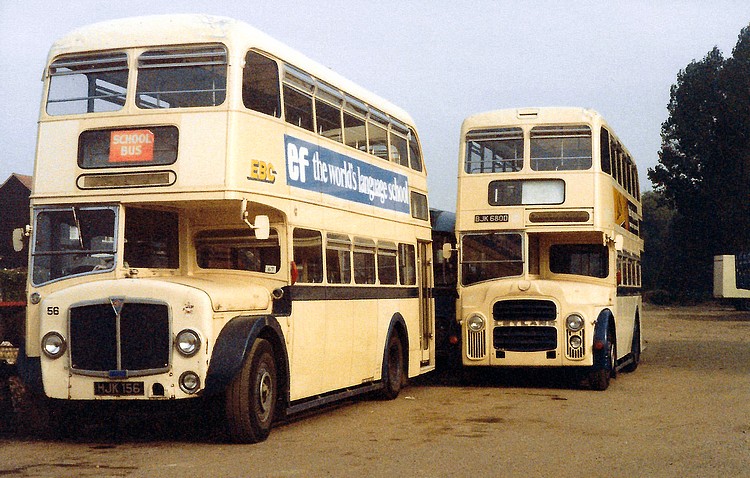
An interesting photo, presumably taken in the yard of Ongar Coaches, High Laver, Essex around
September 1982 when Leyland PD2A no. 80 on the right had just been acquired by them. Still looking shiny and fresh, it was
scrapped two years later. On the left is AEC Regent no. 56 which was five years older and had been with Ongar Coaches for a year
(surprisingly still wearing an EBC logo and fleet number). It was about to be sold to Busby Coaches in Harlow. Photo by kind
permission of Leon Coast.
Delivered Mar-Apr 1966, all in service by early May.
Chassis: Leyland Titan PD2A/30
Body: East Lancs H32/28R with St.Helens-style fibreglass front grille.
Notes: Delivered in blue / primrose livery, but later repainted cream / blue around 1970. The first
Eastbourne buses to be delivered with separate route number blinds.
Buses magazine for Dec 1971 noted: because delay in the delivery of the 1972 Leyland Atlanteans is
expected, it has been decided to convert one Leyland PD2 to front entrance for omo (with Autofare equipment) and, if successful,
the other 14 PD2s will be dealt with similarly. In the November 1972 edition of the same magazine it said the plan to convert a
Leyland PD2A/30 to front entrance has been shelved because of its cost.
- 71 (BJK 671D) c/n L44479, b/n 6360 - Delivered 3/66. Withdrawn 8/81. To Eastbourne Titan Preservation Group 9/81. Later with Danesbury Pullman, Congleton. **SURVIVOR** VisiBuzz, Belgium 2003, for sale Nov 2003 for Euro 34500, but still apparently with VisiBuzz (painted red) in 2006. Returned to UK 2007 for refurbishment to use as European promotional vehicle on behalf of Adidas and Foot Locker, exterior painted by graffiti artists. Returned to UK again, and seen in yard of London Bus Export Co, Lydney in March 2008. By 2009 painted black as merchandising sales bus for Saracens Rugby Club, Watford. Back at Lydney by 2011. In use as route 14 bar at Truckfest, Peterborough 5/16.
- 72 (BJK 672D) c/n L44480, b/n 6358 - Delivered 3/66. Withdrawn 1/83. To J and J. Film Foods (Johnny Vaughan Dining Buses), London N1 3/84 as a mobile diner. **SURVIVOR** Southdown Historic Vehicle Trust, Worthing 2003, to Garth Porrell, Eastbourne 2010. To Seaford & District, Seaford Sept 2019. To James Eastwood, Troopers Lodge Garage, Bourton-on-the-Hill by 2020. Sold by 8/21.
- 73 (BJK 673D) c/n L44596, b/n 6359 - Delivered 3/66. Withdrawn 1/83. To Miss J.Loake, Polegate 4/83 for preservation, and later to M. Evans, Eastbourne. To Brian Birks and then to Nottinghamshire preservationist in 1995 who subsequently restored the bus. Photo in Steyning, Jan 2014 by Paul Green**SURVIVOR** To Ian Pleace, Raynes Park, August 2013.
- 74 (BJK 674D) c/n L44597, b/n 6361 - Delivered 3/66. Withdrawn 3/79, became driver trainer. To Booth (dealer), Rotherham c.6/82, then into preservation. D.B.Ames, Boothville, Northampton 9/84. **SURVIVOR** Sharp, Newmilns, Scotland 2006. Chris Pearce, Worthing 2011. For sale, partly restored, £4000 ono Jan 2013. With Ian Pleace, Raynes Park 2017 - long-term project.
- 75 (BJK 675D) c/n L44854, b/n 6362 - Delivered 3/66. Withdrawn 5/82. Sold to Booth (dealer), Rotherham 7/82 but not taken. Still in Eastbourne 1984. **SURVIVOR** Mobile home, blue and silver, Gressenhall, Norfolk 2004. For sale on eBay (and elsewhere) seeking an opening bid of £7,500 Dec 2014. No MoT, needing work. At Hooton Park, Wirral 2015 in good shape with Barker's Motors, Wrexham, still as blue/silver mobile home. Photo by Ken Jones, Hooton Park 5/15. Returned to Eastbourne livery by 2016 and in use for hires/weddings etc by 2018.
- 76 (BJK 676D) c/n L44855, b/n 6363 - Delivered 3/66. Withdrawn 2/83, and sold to Booth (dealer), Rotherham, then immediately to J. Heuze, Treillieres, France, moving to Vigneux de Bretagne in 1989. **SURVIVOR**To Danny Chabaud, Lavoux, France 8/91 and restored to Eastbourne livery. Sold 10/95 to Novoviandes, a butchers shop group, Villeneuve St Georges, as an advertisement vehicle. Sold to Mr Tymen, Karting, Noyal sur Vilaine, Brittany 6/00 (Probably Kart'In City, indoor kart circuit, Rue de la Giraudiere, Zone Industriale, Noyal sur Vilaine). In bad condition with all window glass broken. A door had been been fitted on right hand side.
- 77 (BJK 677D) c/n L60153, b/n 6365 - Delivered 4/66. Withdrawn 5/82. To B.Birks, Eastbourne (later East Grinstead) c.8/82 for preservation. To Road Transport Training Service, Mendlesham 3/86. **SURVIVOR** Camping de Hiegraaf campsite, Woudenburg, near Amersfoort, Netherlands 2006, good condition, in use as a snack bu'.
- 78 (BJK 678D) c/n L60154, b/n 6364 - Delivered 4/66. Withdrawn 8/82, sold to Booth (dealer), Rotherham. To P. Bird (Ongar Coaches), High Laver 9/82. To Havering and District by 12/84. With Priddle, Farnham, but then to Glasgow Bus Museum, broken up Jan/Feb 2002. Spares used in restoration of no. 72 above.
- 79 (BJK 679D) c/n L60380, b/n 6366 - Delivered 4/66. Hit a tree in Seaside 5 Sept 1977. Withdrawn 11/77. Stripped for spares 1978, remains sold to Booth (dealer), Rotherham 12/78 and scrapped 1/79.
- 80 (BJK 680D) c/n L60381, b/n 6367 - Delivered 4/66. The first PD2 to receive the new cream livery in 1970, and the first to receive the new darker blue / cream livery, 1974. Withdrawn 8/82, sold to Booth (dealer), Rotherham. To P. Bird (Ongar Coaches), High Laver 9/82. To J. Sykes (dealer), Carlton 3/84 for scrap.
LEYLAND TITAN PD2A - 81-85(3rd series) Total: 5

No. 84 on the seafront after having its roof removed in 1973. This bus was later transferred to
Blackpool in exchange for a closed-top PD3 which became no. 81. Photo from Adrian Clarke.
Delivered June 1967
Chassis: Leyland Titan PD2A/30
Body: East Lancs H32/28R with St.Helens-style fibreglass front grille.
Notes: Eastbourne's last new rear-entrance buses, and the last delivered in the blue/primrose
livery.
- 81 (DHC 781E) c/n 700951, b/n 6532 - Withdrawn 11/81, to Rollinson (dealer), Carlton.
- 82 (DHC 782E) c/n 700952, b/n 6535. Loaned to London Buses Ltd. as a driver trainer 4/86 to 5/86. **SURVIVOR** Eastbourne Buses, restored at the East Lancs / Optare facility, Blackburn, 2007-2009. Stagecoach South East Heritage Fleet no. 19978, Eastbourne. For sale Nov 2022.
- 83 (DHC 783E) c/n 700953, b/n 6534 - The last bus to receive the lighter blue / cream livery. Withdrawn 1980, to dealer, Barnsley 10/81.
- 84 (DHC 784E) c/n 701081, b/n 6531 - Rebuilt (top of roof removed) 6/73 to open top O32/28R and painted pale blue. Repainted cream and blue in 1979 and named "Seafront Sunbus". Fitted with tachograph 1983. Upper deck side windows removed and replaced with handrails 5/85. Exchanged in Feb 1989 for Blackpool no. 532 Leyland PD3/11 LFR 532F (which became Eastbourne no. 81 - see below). Became the second no. 532 in the Blackpool fleet, renumbered 432 in Aug 1996. Mac Tours, Edinburgh 2002. Possibly to Ensignbus 2003 for sale. With Chris Pearce, Sussex 2010. To David Mulpeter, t/a Seaford and District 2013. To James Eastwood, Troopers Lodge Garage, Bourton-on-the-Hill by 2020. **SURVIVOR**.
- 85 (DHC 785E) c/n 701082, b/n 6533 - Loaned to Brighton 5/75 to 8/75. Withdrawn 5/80, became service vehicle for Highways Dept. as open top. Probably later scrapped.
LEYLAND TITAN PD3A - 81 (4th series) Total: 1
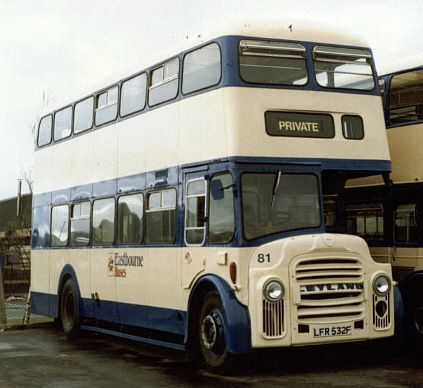
No. 81 (LFR 532F) seen at Eastbourne in the 1990s. Photo by kind permission of Jim Gorman.
Delivered to Blackpool July 1968, transferred to Eastbourne in February 1989.
Chassis: Leyland Titan PD3A/1
Body: Metro-Cammell Weymann H41/30R with St.Helens-style fibreglass front grille.
Notes: New to Blackpool Corporation in July 1968 as their no. 532 (a very late Titan PD3),
withdrawn in January 1983 and became a driver trainer. Last used as such around February 1987, and had a protracted overhaul back
to passenger standards and returned to service January 1988. Withdrawn November 1988 (at the end of regular PD3 operation).
Transferred in February 1989 to Eastbourne Buses in exchange for open top Titan PD2A no. 84 (DHC 784E), which also became no. 532
in the Blackpool fleet. Repainted in full Eastbourne livery. To Lister, Bolton (dealer) March 1993 and sold to Stevenson's,
Uttoxeter. Withdrawn and sold July 1994 to J.Roberts (Photobus Ltd), Rimbey, Alberta, Canada (although Ebay notes suggested 1993).
Used briefly as a tour bus, but out of use from 1997. In Calgary, Alberta 2002, for sale on eBay 7/02 for US$16,500 with photos
showing it in Eastbourne livery with Stevensons legal lettering. For sale again on eBay in March 2006 for US$10,000, and in
Castle Rock, Colorado by 2015. Acquired by Little London Kitchen,
Birmingham, Alabama by 2022 and named the Duchess.
- 81 (LFR 532F) c/n 800836. **SURVIVOR** Exported to Canada around 1993 for use as a tour bus. In Calgary, Alberta by 2002, in Castle Rock, Colorado by 2015, in Birmingham, Alabama by 2022. See details above.
TOTAL 123 (with 19 Survivors, 95, 16, 17, 42 , 57, 65, 66, 67, 68, 69, 71, 72, 73, 74, 75, 76, 77,
81(2nd), 82, 84 )
For more Eastbourne buses see the single deckers,
seafront buses and photo album pages.
For many other buses, have a look at all the other profiles on the Classic
Buses menu page.
SOME LINKS WITHIN THIS WEBSITE:
Home
Email
Links
THE COMPLETE WEBSITE MENU
Events Diary
Halfcab list
Small-Ads
Classic Irish Buses
Classic Manx Buses
SB




































